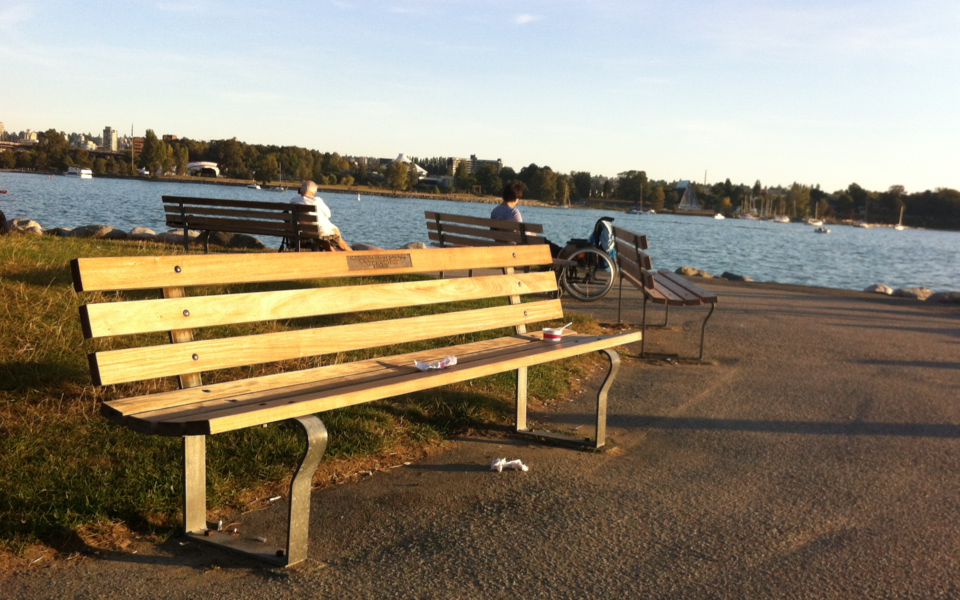Disabled writer and policy analyst Gabrielle Peters doesn’t live far from English Bay, so when the benches were recently removed from Inukshuk Point for her it was emblematic of a more pervasive problem with seating along popular Vancouver walking routes.
The spot of four benches has sufficient space for wheelchair users to transfer out of their chairs and onto the benches comfortably, she says.
Peters, who does a lot of work on the issue of accessibility, is a non-ambluatory wheelchair user but used to use a cane and walker.
“The presence or absence of seating made the difference between whether I could go outside or not,” she explains. “I organized my routes around where there was seating.”
The factor that shrank the world for her was a lack of seating, not her illness, she says.
“My condition was unpredictable, especially in the early stages, so I needed to know I would never be too far from a place to sit down.”
Peters often tells people that a good way to gauge if a place is accessible is by looking to see if there are any disabled people present and you could often see many disabled people of all ages near the seawall at English Bay.
“I felt so genuinely sad when I saw that photo with the benches gone because I knew that it also meant the people who normally sit there would be gone as well,” she says.
Removing seating can mean the difference between having access to public space and not for someone with a chronic illness or other disability.
Peters compares it to a building with entrance stairs and no ramp, not everyone can get it.
She understands that in the case of the English Bay beach benches, it’s a temporary situation but feels removing them for the sake of a pop up plaza tells some communities that their needs can be sacrificed for the sake of another, “essentially turning what should be a human right into something that is conditional based on whether it suits and is convenient for others.”
Peters thinks that the city didn't just remove benches - they also removed community members who already have limited access to public space.
“Policymakers will often express concern about the isolation of disabled and/or older people, but then make decisions that contribute to it,” she says. “There is a disconnect between their words of concern and their actions and priorities and it is important to bring it to their attention.”
What can be done to create more accessibility in Vancouver?
Peters says Vancouver doesn’t have anywhere near enough public seating available and finds it disheartening to see local government bodies decide to eliminate existing accessibility when there is already so much work to be done introducing it to spaces where none exists.
She believes that all transit stops should also have seating as well as weather protection. And that benches and other public seating needs to be regularly and predictably placed, not just along the seawall but around the city.
“If you can't count on it to be there it means the space is not accessible,” she points out.
Vancouver has a large amount of outdoor patios with seating along popular stretches of road and in lots of different neighbourhoods but they’re not necessarily wheelchair friendly or accessible to people with disabilities and mobility issues or if they are, the washroom may not be.
Additionally, there is a cost barrier for most private seating and patios.
“It may seem minor to non-disabled people in Vancouver,” the advocate says, “but where you may have a short list of favourite spots, many of us have a shorter list of places where it is even plausible for us to go.”
Peters suggests that Vancouver needs benches on every block, placed near corners and with shade considerations.
“I want to make clear that when I say every block, I mean every block,” she says, “not just arterials which are noisy and where there is more pollution.”
The type of seating also matters.
It can’t be too low, and for people with neuromuscular conditions who struggle to get up from a seated position, armrests are beneficial.
“When designing, it is important to remember that some [people] are thin and some are fat - we come in different sizes. Seating like those folding patio chairs that look like they would blow away if someone sneezed too hard cater to a very narrow group of non-disabled people,” she points out.
Back in 2017, Peters was a member of the Active Transportation Policy Council and contacted the City and asked them to put together a map of all the washrooms and seating publicly available in Vancouver that included grade changes, proximity to water fountains and shade, and whether the corners had curb cuts.
She says she offered numerous times over the years to put the map together herself but needed them to supply her with the raw data.
She hasn’t received it to date and says that without the information, it is difficult for her to say where precisely the seating is most needed.



